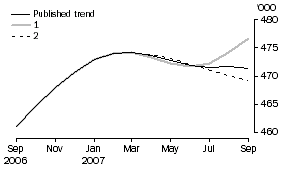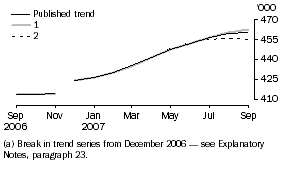TECHNICAL NOTE TREND REVISIONS
EFFECT OF NEW SEASONALLY ADJUSTED ESTIMATES ON TREND ESTIMATES
1 The most recent trend estimates for short-term visitor arrivals and short-term resident departures are likely to be revised when the next month's seasonally adjusted estimates become available. To assist readers of this publication in analysing short-term movement trends, the approximate effects of two possible scenarios on the previous trend estimate of short-term visitor arrivals and resident departures are presented below.
Visitor arrivals
- The October seasonally adjusted estimate of visitor arrivals is 2.8% higher than September.
- The October seasonally adjusted estimate of visitor arrivals is 2.8% lower than September.
WHAT IF...? REVISIONS TO TREND ESTIMATES

Resident departures
- The October seasonally adjusted estimate of resident departures is 3.0% higher than September.
- The October seasonally adjusted estimate of resident departures is 3.0% lower than September.
WHAT IF...? REVISIONS TO TREND ESTIMATES(a)

2 The figures of 2.8% for visitor arrivals and 3.0% for resident departures were chosen because they represent the average absolute monthly percentage change for visitor arrivals and resident departures over the last ten years, respectively.
3 Under concurrent seasonal adjustment, the most recent seasonally adjusted and trend estimates are likely to be revised when original estimates for subsequent months become available. The trend revision is a combined result of the revision of the seasonally adjusted estimates and the revision derived from the use of asymmetric moving averages as future data become available. ABS research shows that about 75% of the total revision to the trend estimate at the current end of the time series is due to the use of different asymmetric moving averages when the original estimate for the next time period becomes available. To assess the reliability of the trend estimate at the current end, the 'what-if' charts present trend estimates under two different scenarios for the next time period. The charts show only the impact due to the changes of the asymmetric moving averages and do not include the unknown impact of revision to seasonal factor estimates that would arise when the original estimate for the next time period becomes available.
 Print Page
Print Page
 Print All
Print All